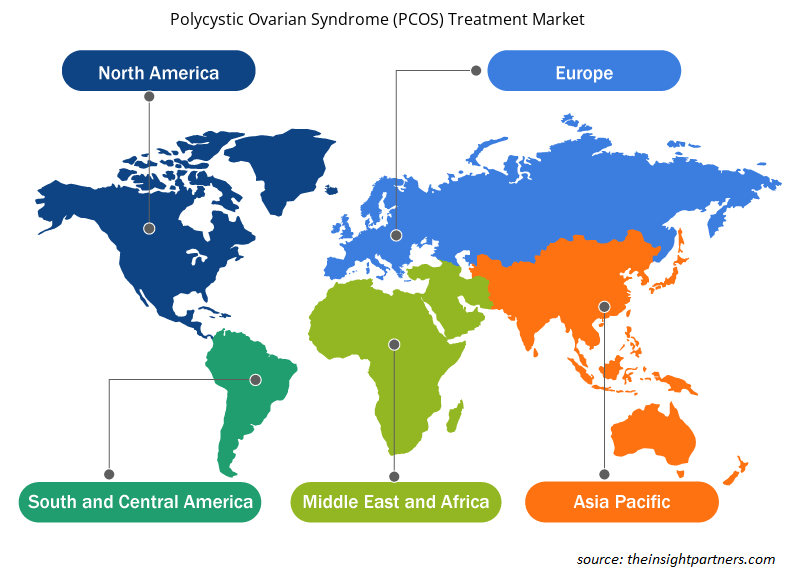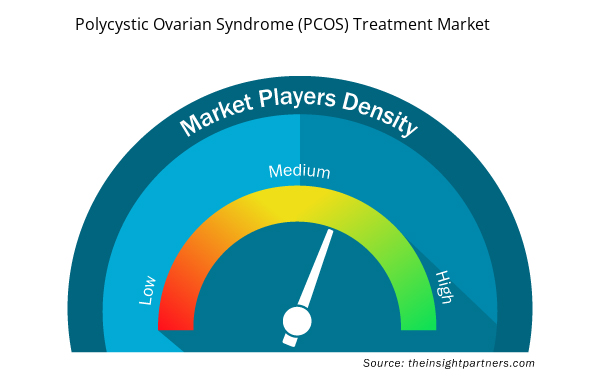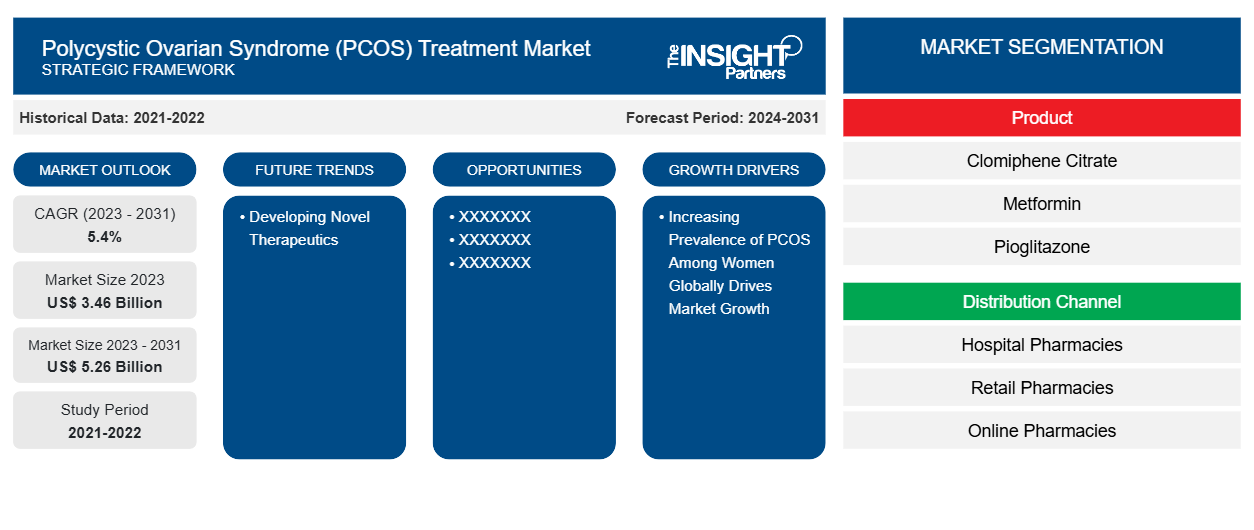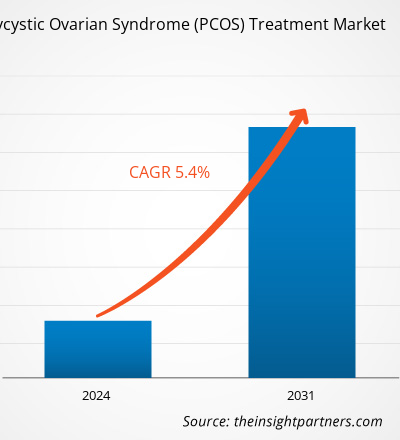다낭성 난소 증후군(PCOS) 치료 시장 전망은 이 시장의 이해 관계자가 성장 전략을 설명하는 데 도움이 됩니다. 이 시장은 2023년 34억 6,000만 달러에서 2031년 52억 6,000만 달러로 성장할 것으로 예상되며, 2023~2031년 동안 5.4%의 CAGR을 기록할 것으로 추산됩니다.
PCOS의 전 세계적 유병률 증가와 PCOS 치료에 대한 의료비 지출의 상당한 증가는 다낭성 난소 증후군(PCOS) 치료 시장 성장을 촉진하는 요인입니다. 예를 들어, 미국에서 약 600만 명의 여성이 일반적인 호르몬 불균형인 PCOS를 앓고 있습니다. 자궁 내막암, 고혈압, 2형 당뇨병, 불임 및 뇌졸중과 같은 여러 질병의 위험을 높입니다. 게다가 내분비 학회는 생식 연령의 여성에게 영향을 미치는 가장 흔한 호르몬 장애인 다낭성 난소 증후군(PCOS)의 진단 및 치료 비용이 2020년에 전국적으로 80억 달러에 달할 것으로 추정합니다.
새로운 치료법이 개발됨에 따라 예측 기간 동안 다낭성 난소 증후군(PCOS) 치료 시장 동향이 새로 나타날 것입니다.
성장 동인:
전 세계 여성들 사이에서 PCOS 유병률 증가로 다낭성 난소 증후군(PCOS) 치료 시장 성장 촉진
다낭성 난소 증후군(PCOS)은 여성에게 흔한 다인자성 내분비 장애입니다. 세계보건기구(WHO)에 따르면, PCOS는 생식 연령 여성의 약 8~13%에 영향을 미칩니다. 전 세계적으로 PCOS는 무배란의 가장 흔한 원인이고 불임의 주요 원인입니다. 또한 PCOS에 걸린 여성의 약 70%는 진단받지 못한 상태입니다. 건강에 해로운 생활 방식과 일부 환경 요인이 PCOS를 일으킬 수 있습니다. 비만은 과도한 체지방이 호르몬 수치와 인슐린 민감성을 방해하여 PCOS가 발병할 수 있으므로 PCOS의 주요 위험 요인입니다. 전 세계적으로 비만이 만연함에 따라 더 많은 여성이 PCOS에 걸릴 위험이 있습니다. 세계 비만 연맹의 세계 비만 지도 2022에 따르면, 2030년까지 전 세계적으로 10억 명 이상이 비만의 영향을 받을 것이며, 여기에는 5명 중 1명의 여성이 포함됩니다.
또한 PCOS의 유병률이 증가함에 따라 효과적인 치료 옵션에 대한 수요가 증가하고 있습니다. 다양한 약물 및 비약물 PCOS 치료법이 호르몬 수치를 조절하고, 인슐린 민감도를 개선하고, PCOS에 기여하는 기타 기저 요인을 해결하는 데 사용할 수 있습니다. 따라서 전 세계 여성 사이에서 PCOS의 유병률이 증가함에 따라 다낭성 난소 증후군(PCOS) 치료 시장이 성장하고 있습니다.
제지:
PCOS에 특화된 FDA 승인 약물의 제한된 가용성은 다낭성 난소 증후군(PCOS) 치료 시장을 방해합니다.
다낭성 난소 증후군(PCOS)과 관련된 복잡한 증상과 근본적인 호르몬 불균형을 해결하기 위해 특별히 설계된 식품의약국(FDA) 승인 약물은 제한적으로 공급됩니다. PCOS의 유병률이 높고 여성의 건강, 생식력, 삶의 질에 미치는 상당한 영향에도 불구하고 이 질환을 치료하기 위해 FDA에서 승인한 약물 옵션(오프라벨 약물)은 비교적 적습니다. FDA 승인 약물이 부족하면 효과적이고 증거 기반의 PCOS 치료법을 찾는 의료 서비스 제공자와 환자에게 어려움이 따릅니다. 경구 피임약, 인슐린 감수성 증가제, 항안드로겐과 같은 특정 약물의 오프라벨 사용은 PCOS 증상을 관리하는 데 일반적이지만 전담 치료법이 없으면 이 질환을 종합적으로 해결할 수 있는 능력이 제한됩니다. 따라서 PCOS에 특별히 적응증이 있는 FDA 승인 약물의 공급이 제한되어 다낭성 난소 증후군(PCOS) 치료 시장 성장이 제한됩니다.
귀하의 요구 사항에 맞게 이 보고서를 사용자 정의하세요
이 보고서의 일부 또는 국가 수준 분석, Excel 데이터 팩을 포함하여 모든 보고서에 대한 사용자 정의를 무료로 받을 수 있으며 신생 기업 및 대학을 위한 훌륭한 혜택과 할인 혜택을 이용할 수 있습니다.
- 이 보고서의 주요 시장 동향을 알아보세요.이 무료 샘플에는 시장 동향부터 추정 및 예측까지 다양한 데이터 분석이 포함됩니다.
보고서 세분화 및 범위:
다낭성 난소 증후군(PCOS) 치료 시장 분석은 제품 및 유통 채널을 고려하여 수행되었습니다.
제품별로 다낭성 난소 증후군(PCOS) 치료 시장은 클로미펜 시트르산염, 메트포르민, 피오글리타존, 경구 피임약 등으로 세분화됩니다. 메트포르민 세그먼트는 2023년에 가장 큰 시장 점유율을 차지했습니다. 또한 클로미펜 시트르산염 세그먼트는 예측 기간 동안 가장 높은 CAGR을 기록할 것으로 예상됩니다.
다낭성 난소 증후군(PCOS) 치료 시장은 유통 채널별로 병원 약국, 소매 약국, 온라인 약국으로 분류됩니다. 병원 약국 부문은 2023년에 가장 큰 다낭성 난소 증후군(PCOS) 치료 시장 점유율을 차지했으며 예측 기간 동안 가장 높은 CAGR을 기록할 것으로 예상됩니다.
지역 분석:
지리적 측면에서 다낭성 난소 증후군(PCOS) 치료 시장 보고서의 범위에는 북미, 유럽, 아시아 태평양, 남미 및 중미, 중동 및 아프리카가 포함됩니다.2023년 북미가 가장 큰 시장 점유율을 차지했습니다. 최신 의료 기기 기술의 채택 증가, PCOS 유병률 증가, 주요 업체의 제품 혁신 증가가 북미에서 다낭성 난소 증후군(PCOS) 치료 시장 규모가 커지는 데 기여하고 있습니다. 미국 보건복지부에 따르면 PCOS는 미국에서 여성 불임의 흔한 원인으로, 생식 연령의 미국 여성의 약 6%~12%(약 500만 명)에 영향을 미칩니다. 2023년 7월 American Journal of Obstetrics and Gynecology에 발표된 연구 "다낭성 난소 증후군 진단의 발생률, 유병률 및 추세"에 따르면 미국에서 PCOS의 발생률은 매년 10,000명당 42.5건입니다. 또한, 미국 내 다양한 기관에서 포괄적인 평가를 제공하고, 인식을 제고하며, PCOS와 관련된 연구에 집중하고 있습니다. 예를 들어, UCSF 생식 건강 센터는 PCOS의 원인을 연구하기 위한 연구에 적극적으로 참여하고 있습니다. 따라서 PCOS의 높은 유병률과 연구 및 인식 제고에 집중하는 기관의 존재는 다낭성 난소 증후군(PCOS) 치료 시장 성장에 유리합니다.
다낭성 난소 증후군(PCOS) 치료 시장 지역 통찰력
Insight Partners의 분석가들은 예측 기간 동안 다낭성 난소 증후군(PCOS) 치료 시장에 영향을 미치는 지역적 추세와 요인을 철저히 설명했습니다. 이 섹션에서는 북미, 유럽, 아시아 태평양, 중동 및 아프리카, 남미 및 중미의 다낭성 난소 증후군(PCOS) 치료 시장 세그먼트와 지리에 대해서도 설명합니다.

- 다낭성 난소 증후군(PCOS) 치료 시장에 대한 지역별 데이터 얻기
다낭성 난소 증후군(PCOS) 치료 시장 보고서 범위
| 보고서 속성 | 세부 |
|---|---|
| 2023년 시장 규모 | 34억 6천만 달러 |
| 2031년까지 시장 규모 | 52억 6천만 달러 |
| 글로벌 CAGR (2023-2031) | 5.4% |
| 역사적 데이터 | 2021-2022 |
| 예측 기간 | 2024-2031 |
| 다루는 세그먼트 | 제품별로
|
| 포함된 지역 및 국가 | 북아메리카
|
| 시장 선도 기업 및 주요 회사 프로필 |
|
다낭성 난소 증후군(PCOS) 치료 시장 참여자 밀도: 비즈니스 역학에 미치는 영향 이해
다낭성 난소 증후군(PCOS) 치료 시장은 소비자 선호도의 변화, 기술 발전, 제품의 이점에 대한 인식 증가와 같은 요인으로 인해 최종 사용자 수요가 증가함에 따라 빠르게 성장하고 있습니다. 수요가 증가함에 따라 기업은 제품을 확장하고, 소비자의 요구를 충족하기 위해 혁신하고, 새로운 트렌드를 활용하여 시장 성장을 더욱 촉진하고 있습니다.
시장 참여자 밀도는 특정 시장이나 산업 내에서 운영되는 회사나 기업의 분포를 말합니다. 주어진 시장 공간에 얼마나 많은 경쟁자(시장 참여자)가 존재하는지 그 규모나 총 시장 가치에 비해 나타냅니다.
다낭성 난소 증후군(PCOS) 치료 시장에서 활동하는 주요 회사는 다음과 같습니다.
- 사노피 SA,
- 머크 KGaA,
- 노바티스,
- 마일란,
- 다케다제약 주식회사
- 애벗,
면책 조항 : 위에 나열된 회사는 어떤 특별한 순서에 따라 순위가 매겨지지 않았습니다.

- 다낭성 난소 증후군(PCOS) 치료 시장 주요 주요 업체 개요 알아보기
산업 발전 및 미래 기회:
회사 보도 자료에 따르면, 다낭성 난소 증후군(PCOS) 치료 시장에서 활동하는 선도적 업체들의 몇 가지 전략적 개발 사항은 아래와 같습니다.
- 2023년 4월, 셀매틱스는 새로운 PCOS 약물 프로그램을 시작했습니다. 이 회사는 중추 신경계(CNS) 외부의 멜라토닌 수용체를 표적으로 하는 가장 최근의 치료 프로그램을 공개했습니다. 이 치료적 의약품은 PCOS부터 시작하여 잠재적으로 자궁 내막증과 폐경 증상을 포함하도록 확장되는 다양한 여성 건강 상태에 대한 효과적인 1차 치료법에 대한 중요한 시장 갭을 메울 것입니다.
- 2022년 1월, Celmatix Inc.는 Evotec과의 5년 다중 타겟 제휴에서 이정표적 성과를 발표했습니다. Evotec과 Bayer AG는 이정표를 촉발하여 새로운 Celmatix 식별 약물 타겟을 중심으로 한 PCOS 약물 프로그램을 히트 식별로 발전시켰습니다.
경쟁 환경 및 주요 회사:
Sanofi SA, Merck KGaA, Novartis, Mylan, Takeda Pharmaceutical Company Ltd, Abbott, Teva Pharmaceuticals, Salix Pharmaceuticals Inc, AstraZeneca, Pfizer Inc는 다낭성 난소 증후군(PCOS) 치료 시장 보고서에 소개된 대표적인 회사입니다. 이러한 회사는 새로운 기술 개발, 기존 제품 업그레이드, 그리고 전 세계적으로 증가하는 소비자 수요를 충족하기 위한 지리적 입지 확대에 중점을 두고 있습니다.
- 역사적 분석(2년), 기준 연도, CAGR을 포함한 예측(7년)
- PEST 및 SWOT 분석
- 시장 규모 가치/양 - 글로벌, 지역, 국가
- 산업 및 경쟁 환경
- Excel 데이터 세트


- Helicopters Market
- Architecture Software Market
- Broth Market
- Playout Solutions Market
- Employment Screening Services Market
- Airline Ancillary Services Market
- Micro-Surgical Robot Market
- Nitrogenous Fertilizer Market
- Excimer & Femtosecond Ophthalmic Lasers Market
- Nuclear Decommissioning Services Market

Report Coverage
Revenue forecast, Company Analysis, Industry landscape, Growth factors, and Trends

Segment Covered
This text is related
to segments covered.

Regional Scope
North America, Europe, Asia Pacific, Middle East & Africa, South & Central America

Country Scope
This text is related
to country scope.
자주 묻는 질문
Factors such as the increasing prevalence of polycystic ovary syndrome (PCOS) among women globally and increasing government initiatives and support for research in the field of reproductive health propel the polycystic ovarian syndrome (PCOS) treatment market growth. However, the limited availability of FDA-approved medications specifically for PCOS hamper the growth of the market.
Polycystic Ovary Syndrome (PCOS) is a hormonal disorder that causes enlarged ovaries with cysts on their outer edges. Some symptoms of PCOS include excess hair growth, acne, missed or irregular menstrual periods, infertility, and weight gain.
The polycystic ovarian syndrome (PCOS) treatment market was valued at US$ 3.46 billion in 2023.
The polycystic ovarian syndrome (PCOS) treatment market majorly consists of the players, including Sanofi SA, Merck KGaA, Novartis, Mylan, Takeda Pharmaceutical Company Ltd, Abbott, Teva Pharmaceuticals, Salix Pharmaceuticals Inc, AstraZeneca, and Pfizer Inc
The market, by distribution channel, is categorized into hospital pharmacies, retail pharmacies, and online pharmacies. The hospital pharmacies segment held the largest polycystic ovarian syndrome (PCOS) treatment market share in 2023, and it is anticipated to register the highest CAGR during the forecast period.
The polycystic ovarian syndrome (PCOS) treatment market is expected to be valued at US$ 5.26 billion in 2031.
By product, the market is segmented into clomiphene citrate, metformin, pioglitazone, oral contraceptives, and others. The metformin segment held a larger polycystic ovarian syndrome (PCOS) treatment market share in 2023. Further, the clomiphene citrate segment is anticipated to register a faster CAGR during the forecast period.
Trends and growth analysis reports related to Life Sciences : READ MORE..
The List of Companies - Polycystic Ovarian Syndrome (PCOS) Treatment Market
- Sanofi SA
- Merck KGaA
- Novartis
- Mylan
- Takeda Pharmaceutical Company Ltd
- Abbott
- Teva Pharmaceuticals
- Salix Pharmaceuticals, Inc
- AstraZeneca
- Pfizer Inc
The Insight Partners performs research in 4 major stages: Data Collection & Secondary Research, Primary Research, Data Analysis and Data Triangulation & Final Review.
- Data Collection and Secondary Research:
As a market research and consulting firm operating from a decade, we have published and advised several client across the globe. First step for any study will start with an assessment of currently available data and insights from existing reports. Further, historical and current market information is collected from Investor Presentations, Annual Reports, SEC Filings, etc., and other information related to company’s performance and market positioning are gathered from Paid Databases (Factiva, Hoovers, and Reuters) and various other publications available in public domain.
Several associations trade associates, technical forums, institutes, societies and organization are accessed to gain technical as well as market related insights through their publications such as research papers, blogs and press releases related to the studies are referred to get cues about the market. Further, white papers, journals, magazines, and other news articles published in last 3 years are scrutinized and analyzed to understand the current market trends.
- Primary Research:
The primarily interview analysis comprise of data obtained from industry participants interview and answers to survey questions gathered by in-house primary team.
For primary research, interviews are conducted with industry experts/CEOs/Marketing Managers/VPs/Subject Matter Experts from both demand and supply side to get a 360-degree view of the market. The primary team conducts several interviews based on the complexity of the markets to understand the various market trends and dynamics which makes research more credible and precise.
A typical research interview fulfils the following functions:
- Provides first-hand information on the market size, market trends, growth trends, competitive landscape, and outlook
- Validates and strengthens in-house secondary research findings
- Develops the analysis team’s expertise and market understanding
Primary research involves email interactions and telephone interviews for each market, category, segment, and sub-segment across geographies. The participants who typically take part in such a process include, but are not limited to:
- Industry participants: VPs, business development managers, market intelligence managers and national sales managers
- Outside experts: Valuation experts, research analysts and key opinion leaders specializing in the electronics and semiconductor industry.
Below is the breakup of our primary respondents by company, designation, and region:

Once we receive the confirmation from primary research sources or primary respondents, we finalize the base year market estimation and forecast the data as per the macroeconomic and microeconomic factors assessed during data collection.
- Data Analysis:
Once data is validated through both secondary as well as primary respondents, we finalize the market estimations by hypothesis formulation and factor analysis at regional and country level.
- Macro-Economic Factor Analysis:
We analyse macroeconomic indicators such the gross domestic product (GDP), increase in the demand for goods and services across industries, technological advancement, regional economic growth, governmental policies, the influence of COVID-19, PEST analysis, and other aspects. This analysis aids in setting benchmarks for various nations/regions and approximating market splits. Additionally, the general trend of the aforementioned components aid in determining the market's development possibilities.
- Country Level Data:
Various factors that are especially aligned to the country are taken into account to determine the market size for a certain area and country, including the presence of vendors, such as headquarters and offices, the country's GDP, demand patterns, and industry growth. To comprehend the market dynamics for the nation, a number of growth variables, inhibitors, application areas, and current market trends are researched. The aforementioned elements aid in determining the country's overall market's growth potential.
- Company Profile:
The “Table of Contents” is formulated by listing and analyzing more than 25 - 30 companies operating in the market ecosystem across geographies. However, we profile only 10 companies as a standard practice in our syndicate reports. These 10 companies comprise leading, emerging, and regional players. Nonetheless, our analysis is not restricted to the 10 listed companies, we also analyze other companies present in the market to develop a holistic view and understand the prevailing trends. The “Company Profiles” section in the report covers key facts, business description, products & services, financial information, SWOT analysis, and key developments. The financial information presented is extracted from the annual reports and official documents of the publicly listed companies. Upon collecting the information for the sections of respective companies, we verify them via various primary sources and then compile the data in respective company profiles. The company level information helps us in deriving the base number as well as in forecasting the market size.
- Developing Base Number:
Aggregation of sales statistics (2020-2022) and macro-economic factor, and other secondary and primary research insights are utilized to arrive at base number and related market shares for 2022. The data gaps are identified in this step and relevant market data is analyzed, collected from paid primary interviews or databases. On finalizing the base year market size, forecasts are developed on the basis of macro-economic, industry and market growth factors and company level analysis.
- Data Triangulation and Final Review:
The market findings and base year market size calculations are validated from supply as well as demand side. Demand side validations are based on macro-economic factor analysis and benchmarks for respective regions and countries. In case of supply side validations, revenues of major companies are estimated (in case not available) based on industry benchmark, approximate number of employees, product portfolio, and primary interviews revenues are gathered. Further revenue from target product/service segment is assessed to avoid overshooting of market statistics. In case of heavy deviations between supply and demand side values, all thes steps are repeated to achieve synchronization.
We follow an iterative model, wherein we share our research findings with Subject Matter Experts (SME’s) and Key Opinion Leaders (KOLs) until consensus view of the market is not formulated – this model negates any drastic deviation in the opinions of experts. Only validated and universally acceptable research findings are quoted in our reports.
We have important check points that we use to validate our research findings – which we call – data triangulation, where we validate the information, we generate from secondary sources with primary interviews and then we re-validate with our internal data bases and Subject matter experts. This comprehensive model enables us to deliver high quality, reliable data in shortest possible time.


 이 보고서에 대한 무료 샘플을 받으세요
이 보고서에 대한 무료 샘플을 받으세요